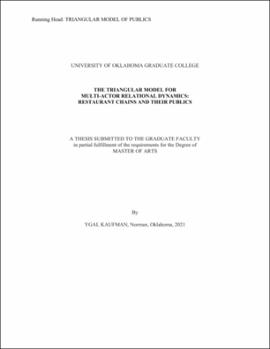| dc.contributor.advisor | Kim, Jeong-Nam | |
| dc.contributor.author | Kaufman, Ygal | |
| dc.date.accessioned | 2021-05-25T15:24:23Z | |
| dc.date.available | 2021-05-25T15:24:23Z | |
| dc.date.issued | 2021-05-14 | |
| dc.identifier.uri | https://hdl.handle.net/11244/329850 | |
| dc.description.abstract | Organizational relationships with external publics are mostly perceived in the context of two-way interactions. In networked digital media platforms, employees or investors who are internal stakeholders and publics engage in communicative interactions with external stakeholders. Some employees in poor relationships with their working companies become expressive in online communities. They may blow whistles, leak, exaggerate problems, exaggerate severity of consequences, or collaborate with external publics against management (e.g., negative megaphoning). Such negative content, once generated and distributed by internal publics, could earn higher credibility with online information seekers.
This study tests a new model of multi-actor relational dynamics in a triangular frame. The strategic value of employee relationships is demonstrated through an inspection of their communicative actions. Using a design of two experimental surveys– one of employees of fast-food restaurants and the other of customers of the same four restaurants– two sides of the triangular model are presented and measured to see how relationship moderates the valence and receptiveness to information from an organization’s internal publics (employees or investors) directly to their external publics (customers). Thus, two sides of the triangle are measured to make inferences about the third. The key concepts being measured are relationship quality and symmetrical communications, so see if they have the predicted effect on communicative action and acceptance of that information.
Results support that positive organization-public relationship (OPR) and symmetrical communications with publics have a direct positive relationship with the effects of employees’ communicative behavior, as well as the credence customers give to that information and their likelihood to further share that information. | en_US |
| dc.language | en_US | en_US |
| dc.rights | Attribution-NonCommercial-NoDerivatives 4.0 International | * |
| dc.rights.uri | https://creativecommons.org/licenses/by-nc-nd/4.0/ | * |
| dc.subject | Public Relations | en_US |
| dc.subject | Symmetrical Communications | en_US |
| dc.subject | triangular model | en_US |
| dc.subject | Organization Public relationship | en_US |
| dc.title | The triangular model for multi-actor relational dynamics: restaurant chains and their publics | en_US |
| dc.contributor.committeeMember | Sung, Yoon-Hi | |
| dc.contributor.committeeMember | Zhang, Angela | |
| dc.date.manuscript | 2021-05 | |
| dc.thesis.degree | Master of Arts | en_US |
| ou.group | Gaylord College of Journalism and Mass Communication | en_US |

